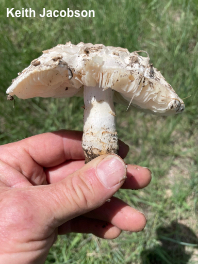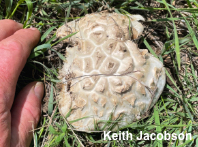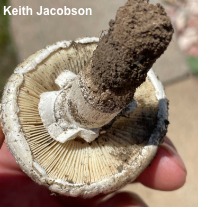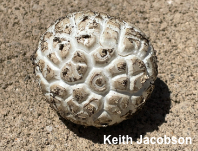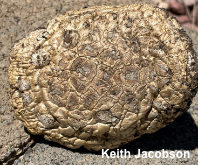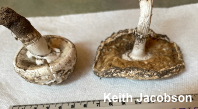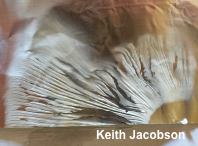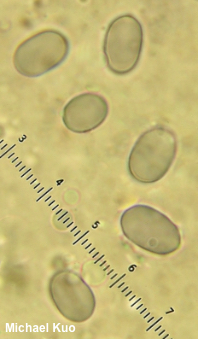| Major Groups > Gilled Mushrooms > Pale-Spored > Amanita > Amanita prairiicola |

|
Amanita prairiicola [ Basidiomycota > Agaricales > Amanitaceae > Amanita . . . ] by Michael Kuo This is an atypical species of Amanita, since it is not associated with trees in a symbiotic, mycorrhizal relationship; instead, Amanita prairiicola is a saprobe that decomposes litter (primarily senescent grass roots). Thus, like Amanita thiersii, it is found in grassy areas, often far from trees, and was given the Latin epithet prairiicola ("prairie loving") when it was first described from Kansas. Distinguishing features for Amanita prairiicola include its whitish cap, with brownish warts, the creamy gills that are free from the stem, the collapsing ring and brownish patches of veil on the stem—and, under the microscope, its elongated-ellipsoid, amyloid spores. Similar grassland amanitas include Amanita thiersii, which is covered with powdery white shagginess and has a Midwestern range that probably only overlaps in Texas and Oklahoma (if at all), and the West Coast's Amanita pruittii, which is more gray and has more warts, along with a striate ring. Amanita subcaligata is another western grasslands, but it is less similar, since its colors are pinkish to pinkish orange and its more slender stem is sheathed with scales of veil. There may be several cryptic species hanging out within Amanita prairiicola; one of these, at a minimum, has been tentatively separated and given a provisional name by Amanita expert Rod Tulloss. Amanita malheurensis is a synonym, as is Saproamanita prairiicola. Thanks to Keith Jacobson for documenting, collecting, and preserving Amanita prairiicola for study; his collection is deposited in The Herbarium of Michael Kuo. Description: Ecology: Saprobic, appearing in grasslands, growing alone or gregariously; originally described from Kansas; distributed in North America from the Great Plains westward to Colorado, the southwestern United States, and southern California; also known from Argentina. The illustrated and described collection is from Colorado. Cap: 5–11 cm across; convex, expanding to broadly convex or planoconvex; dry; white to pale brownish, with brownish to grayish brown, flattened warts; developing cracks and fissures in arid conditions; the margin not lined. Gills: Free from the stem or nearly so; creamy, becoming brownish when past maturity; close; short-gills frequent. Stem: 5–9 cm long; 1–2 cm thick; fairly equal; dry; finely fibrillose; whitish to pale brownish; with a collapsing white ring; universal veil remnants present as brownish patches. Flesh: White; unchanging when sliced. Odor: Not distinctive. Spore Print: Creamy white. Microscopic Features: Spores 10–12 x 6.5–7.5 µm; elongated-ellipsoid; smooth; hyaline in KOH; amyloid. Basidia about 40 x 10 µm; clavate; 4-sterigmate. Hymenial cystidia not found. Pileipellis not differentiated; cap surface a layer of smooth, hyaline elements 5–15 µm wide, with velar sphaerocysts in chains. REFERENCES: C. H. Peck, 1897. (Bas, 1969; Jenkins, 1986; Miller et al., 1990; Tulloss, 2000; Tulloss, 2007; Cripps, Evenson & Kuo, 2016; Redhead et al., 2016; Tulloss et al., 2016; Tulloss, continuously updated.) Herb. Kuo 05232101. This site contains no information about the edibility or toxicity of mushrooms. |
© MushroomExpert.Com |
|
Cite this page as: Kuo, M. (2021, August). Amanita prairiicola. Retrieved from the MushroomExpert.Com Web site: http://www.mushroomexpert.com/amanita_prairiicola.html |
